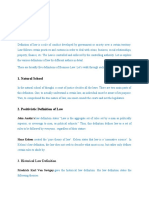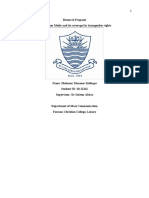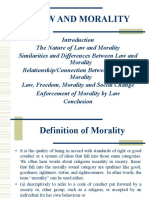Criminal Justice Essay
Criminal Justice Essay
Uploaded by
SexyMP73Copyright:
Available Formats
Criminal Justice Essay
Criminal Justice Essay
Uploaded by
SexyMP73Copyright
Available Formats
Share this document
Did you find this document useful?
Is this content inappropriate?
Copyright:
Available Formats
Criminal Justice Essay
Criminal Justice Essay
Uploaded by
SexyMP73Copyright:
Available Formats
Running head: CRIMINAL JUSTICE ESSAY
Criminal Justice Essay
Dougg Holder
CJ204
October 4, 2012
Mark Hamel
CRIMINAL JUSTICE ESSAY
2
Criminal Justice Essay
Looking at society, the idea of crime has various but substantial roots. Called taboos
or socially unacceptable behavior, certain conduct is not allowed in formal and informal social
structures. A true investigation of crime starts with defining it. Appropriately, segmenting this
definition into how it applies to governmental structure, theories related to crime, and how the
theories and structures build into a system. This investigation culminates with the understanding
of how and why this system is functional if not truly efficient or completely effective.
Crime can be defined as Conduct in violation of the criminal laws of a state, the federal
government, or a local jurisdiction for which there is no legally acceptable justification or
excuse (Schmallager, 2011, p. 7). Said another way, crime has three parts. A government or
collective social determinate group selects the conduct which is socially unacceptable. That
group acts to enumerate, codify, or list the unacceptable behaviors. Finally they find and set aside
specific examples where that behavior, while still unacceptable, is justifiable in certain cases.
This definition can be shown historically and even biblically.
Moses returned from the mountain with two tablets listing the Ten Commandments. This
displays crime in a traditional sense. Moses was the leader of the Israelite nation. Whatever the
source of his role, whether proclaimed by God or elected by popular vote, Moses was the leader
of a fluid but homogenous ethnic group, as the government he found certain behaviors
unacceptable. This was published by the listing of the commandments on tablet slabs. While a
basic system, it still had exceptions. Thou shall not kill was excluded from prosecution in time
of war. Therefore the system of criminal creation and application had deep roots in human
behavior.
CRIMINAL JUSTICE ESSAY
In the United States, crimes are viewed in two ways under the social justice theory.
Crimes are listed as conduct lists that protect the rights of individuals. The opposing view point
is that crimes are lists of conduct that create order to society within the governmental area.
Generally all crime fits into these two categories.
Individual rights advocates see the system as functional, but seek to curb abuses into
person freedoms. This is most notably acknowledged by the Bill of Rights. An enumeration of
rights that are more solemn to the authors of the governmental system show value to how
important personal freedom was in the creation of this country. But even that list has dissenters.
Public Order theorists seek order to the system. An enumerated list can be wieldy and
leave necessary rights out, and can become dated. The current struggle of the Supreme Court is
in applying 200 year old listed rights in a modern world. Personal freedom to have firearms can
conflict with security of social operations. Just ask someone what it would be like to go shopping
next to a person carrying an AK-47 assault rifle if the conflict exists?
All operating, administrating or technical agencies that perform criminal justices
functions make up the criminal justice system. Legislative bodies, whether the federal Congress,
state legislatures or city councils, create and codify laws for the system to utilize. Enforcement
agencies act to cite or arrest persons who do not follow these laws. Judicial officers, generally
lawyers and judges, adjudicate the facts of a matter and if the law was actually broken. Finally,
correction personal make sure the proper rehabilitation or punishment is carried through to
conclusion.
With a history as long as humanity, various and numerous theories have surrounded
criminal conduct. Following the development of science, the theories behind criminality flow
with the expansion of behavioral sciences.
CRIMINAL JUSTICE ESSAY
Generally theories are broken into the groups of Classical and Neoclassical, Biological,
Psychobiological, Psychological, Sociological, Social Process, Conflict and Emergent. Each
theory applies scientific method to behavioral conditions. Genetics, parenting, social
development as well as many other sources are tested and documented as possible sources of
criminal conduct.
People are complex. Therefore each of these theories has some truth, but often the
complexity of human behavior shows that no one theory is absolute. Classical theories apply free
will as a source of all behavior, and all criminal behavior is rational or routine conduct.
Biological, Psychological, and Psychobiological theories look at the genetic, hormonal, chemical
brain structures and how the body, mind, or both contribute to criminal behavior.
Sociological, Social Process, and Conflict theories view the behavior within the social
framework, the effect of social roles and how conflict is socially inevitable as the creation of
crime. Emergent theories lump newer or narrow-view opinions that have more recent sourcing.
These disciplines include feminism criminology, constitutive criminology, and postmortem
criminology. Essentially, each theory looks into the why crime occurs, but dealing with the
when it occurs is the criminal justice system and its processes.
The criminal justice system is a multi-tiered organism involving three components:
police, courts, and corrections. The criminal justice process involves these separate components
working towards a common goal. Equality and fairness should be common ground in the
criminal justice system but often the components are conflicted. Each component should
augment one another, if not then the pieces will not fit together to create a unified system. The
police departments and federal law enforcement agencies throughout the nation enforce laws set
up by local, state, and federal legislature. These agencies are responsible for apprehending
CRIMINAL JUSTICE ESSAY
criminals. The court system imposes the actual sentencing of the convicted criminal. While
corrections is responsible for the physical incarceration of the criminals convicted in a court of
law.
The criminal justice is by definition a functioning system that governs both the innocent
and guilty in society. The system has shown itself to be flawed throughout history. There are
many examples of the wrong person being arrested and sentenced for a crime they did not
commit. Sometimes the supposedly guilty person is exonerated. It has been documented that
through the use of DNA, many incarcerated inmates are found innocent years after they have
been sentenced. Using that same chain of logic, then it must also hold true that certain innocent
inmates may have been given the death penalty as well. I believe that the criminal justice system
in the United States has a lot of room to improve upon itself; however, it is an amazing system
that is constantly being improved upon as our country grows. Fiscal limitations serve to further
hurt the criminal justice system and those who adhere to it. A citizen should never be told that
their security is in jeopardy because of a lack of law enforcement personnel. Or that a criminal
will not serve their entire sentence in prison because of overcrowding. If the criminal justice
system is to thrive, then many aspects of it may have to be reevaluated.
CRIMINAL JUSTICE ESSAY
Reference
Schmallager, F. (2011). Criminal justice today: An introductory text for the 21st century (11th
ed.). Upper Saddle River, NJ: Pearson/Prentice Hall.
You might also like
- Singhal and MalikDocument5 pagesSinghal and MalikAlan WhaleyNo ratings yet
- Special Committee On Reforming The Police ActDocument96 pagesSpecial Committee On Reforming The Police ActChristopherFouldsNo ratings yet
- Criminal Justice - Exam 1 - Study GuideDocument14 pagesCriminal Justice - Exam 1 - Study GuideHightowh0% (1)
- Blessed in The DarknessDocument190 pagesBlessed in The DarknessAnaeli GayosoNo ratings yet
- AdulteryDocument48 pagesAdulteryAtul Narayan100% (1)
- Herbert Lionel Adolphus HartDocument7 pagesHerbert Lionel Adolphus HartLEVI ACKERMANNNo ratings yet
- Journey Through Criminal Justice Systems Law EssayDocument2 pagesJourney Through Criminal Justice Systems Law EssayNavinYattiNo ratings yet
- English Essay 4Document18 pagesEnglish Essay 4api-249673265No ratings yet
- A Third View of Rights and LawDocument13 pagesA Third View of Rights and LawpinoydooyeweerdianNo ratings yet
- Introduction About Law and MoralityDocument6 pagesIntroduction About Law and MoralityDivya YadavNo ratings yet
- Critical Thinking PaperDocument13 pagesCritical Thinking PaperAdelaideNo ratings yet
- AWARENESSLEVELDocument10 pagesAWARENESSLEVELXtine LizaNo ratings yet
- Role of Lawyers in Legal EducationDocument13 pagesRole of Lawyers in Legal EducationAnimesh SinghNo ratings yet
- Evaluation of Business Code of EthicsDocument6 pagesEvaluation of Business Code of Ethicsstevokenevo182No ratings yet
- Lowering The Age of Criminal Responsibility - A Reaction PaperDocument11 pagesLowering The Age of Criminal Responsibility - A Reaction PaperAtty. April PualengcoNo ratings yet
- Research ProposalDocument15 pagesResearch ProposalMahnoor Mansoor100% (1)
- CARREON 3LM4 LM31810 ThoughtPaperAntiTerrorLawDocument7 pagesCARREON 3LM4 LM31810 ThoughtPaperAntiTerrorLawYannah HidalgoNo ratings yet
- Recent Jurisprudence Criminal LawDocument48 pagesRecent Jurisprudence Criminal Lawmarge carreonNo ratings yet
- Crime and CriminologyDocument15 pagesCrime and CriminologyAdiba A. 130No ratings yet
- More Guns, More Crime: Mark DugganDocument29 pagesMore Guns, More Crime: Mark DugganRobin RichardsonNo ratings yet
- Summary Sogie BillDocument3 pagesSummary Sogie BillMa. Oliva Diana CastroNo ratings yet
- Juvenile Delinquency in IndiaDocument4 pagesJuvenile Delinquency in IndiaHarshvardhan MelantaNo ratings yet
- Ladlad Vs ComelecDocument2 pagesLadlad Vs ComelecCarlota Nicolas VillaromanNo ratings yet
- Doctrinal and Non Doctrinal ResearchDocument4 pagesDoctrinal and Non Doctrinal ResearchRahul O Agrawal83% (6)
- Law and MoralityDocument5 pagesLaw and MoralityAkinsola HammadNo ratings yet
- Prelim CLJ2Document8 pagesPrelim CLJ2Ree-Ann Escueta BongatoNo ratings yet
- LGBT Party VsDocument6 pagesLGBT Party VsAnonymous HIBt2h6z7No ratings yet
- Stare Decisis and PDAF in The PhilippinesDocument5 pagesStare Decisis and PDAF in The PhilippinesCamille AngelicaNo ratings yet
- Death Penalty (C)Document7 pagesDeath Penalty (C)Victor VenidaNo ratings yet
- Victim's Access To Justice System in Bangladesh: A Comprehensive StudyDocument39 pagesVictim's Access To Justice System in Bangladesh: A Comprehensive StudyDimasalang PerezNo ratings yet
- Local The Number of Vehicles Registered in The Davao Region Is Increasing. Motor Vehicles in The Region Grew To 632,601 in 2019 From 425,081 in 2016Document3 pagesLocal The Number of Vehicles Registered in The Davao Region Is Increasing. Motor Vehicles in The Region Grew To 632,601 in 2019 From 425,081 in 2016Michael PepitoNo ratings yet
- AR 8353 Anti Rape Law ResearchDocument8 pagesAR 8353 Anti Rape Law Researchmyxyn.myguel.medinaNo ratings yet
- POLI-Session 3 PDFDocument87 pagesPOLI-Session 3 PDFGian MadridNo ratings yet
- Critical Thinking Paper Final DraftDocument11 pagesCritical Thinking Paper Final DraftAnonymous SeVD2Lh3raNo ratings yet
- JusticeDocument5 pagesJustice270651100% (2)
- Chapter 3 - Ethics in Public and Private AdministrationDocument26 pagesChapter 3 - Ethics in Public and Private AdministrationMohamad Faris100% (1)
- Criminology AssignmentDocument28 pagesCriminology AssignmentAnnie MampillyNo ratings yet
- Schneckenburger vs. Moran G.R. No. 44896Document3 pagesSchneckenburger vs. Moran G.R. No. 44896mil loronoNo ratings yet
- Disini v. Secretary of JusticeDocument2 pagesDisini v. Secretary of JusticeNickoNo ratings yet
- Abayon Vs HRET, Palparan Vs HRET, GR Nos. 189466 & 189506Document6 pagesAbayon Vs HRET, Palparan Vs HRET, GR Nos. 189466 & 189506AddAllNo ratings yet
- Research PaperDocument9 pagesResearch PaperMegha BoranaNo ratings yet
- RRLDocument2 pagesRRLclitcheNo ratings yet
- JURISPRUDENCEDocument9 pagesJURISPRUDENCEMaher AfrasiabNo ratings yet
- Introduction To Legal PositivismDocument16 pagesIntroduction To Legal PositivismReni SunartyNo ratings yet
- LLM Amity JP Sir ProjectDocument11 pagesLLM Amity JP Sir ProjectbhanwatiNo ratings yet
- Nps Sample Questions.Document34 pagesNps Sample Questions.John kariuki100% (2)
- Pardon V ProbationDocument2 pagesPardon V ProbationAnonymous lbOiXWCpNo ratings yet
- Topic 3c. Law & MoralityDocument18 pagesTopic 3c. Law & MoralityYuvanesh Kumar100% (1)
- Judicial System of The PhilippinesDocument5 pagesJudicial System of The PhilippinesJacquelyn LopezNo ratings yet
- Political Science Assignment Law and MoralityDocument5 pagesPolitical Science Assignment Law and MoralityRanjeet Mathew JacobNo ratings yet
- Vol 6 Issue 21Document426 pagesVol 6 Issue 21Arnulfo Pecundo Jr.No ratings yet
- Differential Association Theory and Juvenile Delinquency in Ghana's Capital City - Accra: The Case of Ghana Borstal InstituteDocument8 pagesDifferential Association Theory and Juvenile Delinquency in Ghana's Capital City - Accra: The Case of Ghana Borstal InstituteThomas ANTWI BOSIAKOHNo ratings yet
- Juvenile Justice System in IndiaDocument5 pagesJuvenile Justice System in IndiaCHANDRAKALA .B.B.No ratings yet
- Classification of Offences, Theories of PunishmentDocument14 pagesClassification of Offences, Theories of PunishmentKanooni SalahNo ratings yet
- Bench Bar RelationDocument2 pagesBench Bar RelationPrerana ChhapiaNo ratings yet
- Damodaram Sanjivayya National Law University: VisakhapatnamDocument26 pagesDamodaram Sanjivayya National Law University: VisakhapatnamEswar StarkNo ratings yet
- LEGPHILO2019Document13 pagesLEGPHILO2019Jade HernandezNo ratings yet
- Tilted Justice: First Came the Flood, Then Came the Lawyers.From EverandTilted Justice: First Came the Flood, Then Came the Lawyers.Rating: 5 out of 5 stars5/5 (1)
- Justice NetworkDocument5 pagesJustice NetworkVanessa Mae Tangian LabradoNo ratings yet
- Court pillar-WPS OfficeDocument1 pageCourt pillar-WPS Officeramina pollescasNo ratings yet
- Administrative 1Document6 pagesAdministrative 1karmay shrimaliNo ratings yet
- Report On Attendance: Magwawa Integrated SchoolDocument2 pagesReport On Attendance: Magwawa Integrated SchoolEeve YhoungNo ratings yet
- Nutrition For Patients With Metabolic or Respiratory StressDocument27 pagesNutrition For Patients With Metabolic or Respiratory StressYorlenie JuárezNo ratings yet
- Simulacro Cassiel - MonsterDocument2 pagesSimulacro Cassiel - Monsterhenri.santos779No ratings yet
- St. Dogmael's Stone - The Rosetta Stone' of Ogham Studies: AbstractDocument12 pagesSt. Dogmael's Stone - The Rosetta Stone' of Ogham Studies: AbstractEmpresarialNo ratings yet
- Unit-Iii: Figure 4.1: Intermediate Code GeneratorDocument33 pagesUnit-Iii: Figure 4.1: Intermediate Code GeneratorSivaiah PonugotiNo ratings yet
- FSCM Tutorial 6Document3 pagesFSCM Tutorial 6samdukersNo ratings yet
- Hci QBDocument52 pagesHci QBJayaprasannaNo ratings yet
- Unit 5 House and Home LESSON 17Document11 pagesUnit 5 House and Home LESSON 17TeacherNo ratings yet
- KMBN 106 Design ThinkingDocument27 pagesKMBN 106 Design ThinkingFaisal Arif100% (1)
- Understanding Clinical Research TranscriptDocument101 pagesUnderstanding Clinical Research TranscriptjlcrevalcmdNo ratings yet
- Design Criteria For Structural Design of Silage Silo Walls: July 2012Document7 pagesDesign Criteria For Structural Design of Silage Silo Walls: July 2012Bayari ArNo ratings yet
- A River Runs Through It EssayDocument6 pagesA River Runs Through It Essayd3gn731z100% (2)
- Spanish Essay CheckerDocument8 pagesSpanish Essay Checkerlud0b1jiwom3100% (2)
- Job Description - Data OfficerDocument4 pagesJob Description - Data OfficerTracy Halfpenny LondonNo ratings yet
- Uganda Martyrs Ss NamugongoDocument3 pagesUganda Martyrs Ss Namugongojacksonmale41No ratings yet
- Eaton Williams - RHR ManualDocument8 pagesEaton Williams - RHR ManualLuis DomdNo ratings yet
- Bo de Thi Giua Hoc Ky 2 Mon Tieng Anh Lop 8 Co Dap AnDocument21 pagesBo de Thi Giua Hoc Ky 2 Mon Tieng Anh Lop 8 Co Dap AnĐức Anh TrịnhNo ratings yet
- Economics NotesDocument124 pagesEconomics NotesSamiksha ShahNo ratings yet
- LM-700 焦度计英文 说明书 SUPORE 2018年4月21日Document34 pagesLM-700 焦度计英文 说明书 SUPORE 2018年4月21日Dan CocaliaNo ratings yet
- HLSL TutorialDocument13 pagesHLSL TutorialMarkNo ratings yet
- Development 1Document14 pagesDevelopment 1kashifbutty2kNo ratings yet
- CL 6Document6 pagesCL 6MAT1915 Suman MallickNo ratings yet
- Thomas Edison's Best 20 InventionsDocument21 pagesThomas Edison's Best 20 InventionsClay BowmanNo ratings yet
- HW21Document4 pagesHW21李長青No ratings yet
- 10ta - Data Sheet - Flypartsguy - Com - 8.2018Document8 pages10ta - Data Sheet - Flypartsguy - Com - 8.2018Kurd SkorvskiNo ratings yet
- Liceo de Cagayan University: College of Medical Laboratory ScienceDocument3 pagesLiceo de Cagayan University: College of Medical Laboratory ScienceLol lolNo ratings yet
- Design and Performance Diesel Fuel FiltersDocument4 pagesDesign and Performance Diesel Fuel FiltersJaskirat Singh100% (1)
- Report On Advance JavaDocument35 pagesReport On Advance JavaVertika Srivastava63% (8)
- Lapaoran Teleng & EPMSDocument22 pagesLapaoran Teleng & EPMSRii UtamiNo ratings yet

























































































